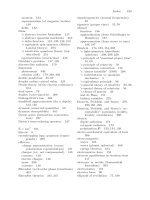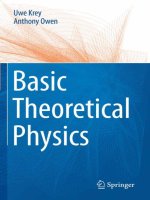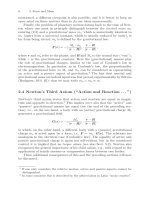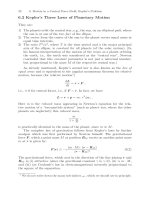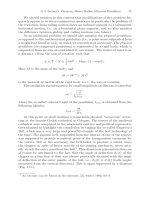- Trang chủ >>
- Khoa Học Tự Nhiên >>
- Vật lý
Basic Theoretical Physics: A Concise Overview P42 potx
Bạn đang xem bản rút gọn của tài liệu. Xem và tải ngay bản đầy đủ của tài liệu tại đây (244.24 KB, 10 trang )
428 55 Conclusion to Part IV
For a grand canonical ensemble, where the heat bath not only exchanges
energy with the system, but also particles, such that the particle number in
avolumeelementV fluctuates around the average N(T,μ,V), in addition to
β
=
1
k
B
T
,
one obtains for the distribution a second parameter μ (the so-called chemical
potential ) for the analogous quantity to the Helmholtz free energy, i.e., for
the Gibbs grand canonical thermodynamic potential:
Φ(T,μ,V, )=−k
B
T · ln Z(T,μ,V, ) ,
with the grand canonical partition function:
Z(T,μ,V, )=
i,j
e
−
E
i
(V,N
j
)−μN
j
k
B
T
.
The mathematical relation between the Helmholtz free energy and the
Gibbs grand canonical potential Φ is a Legendre transform, i.e.:
Φ(T,μ,V, )=F (T,V,N(T,μ,V), ) − μ · N(T,μ,V) ,
similarly to the way the internal energy U(T,V,N, )andtheenthalpy I
depend on each other:
I(T,p,N, )=U(T,V(T,p,N, ),N, )+p · V (T,p,N, ) ,
with the pressure p as the conjugate Lagrange parameter regulating fluctua-
tions in V .
These Legendre transformations are mathematically analogous to the
transition from the Lagrange function L(v, )
2
to the Hamilton function
H(p, ) in classical mechanics; incidentally (this may be used for mnemonic
purposes!) the corresponding letters are similar, i.e., V (and v)andp (and
p), although the meaning is completely different.
The relation between a) and b) can also be expressed as
U(T,V,N, ) ≡H(V,N, )
T
.
Where
ˆ
A
T
is the thermodynamic expectation with the suitable canoni-
cal (and microcanonical and grand canonical ) Boltzmann-Gibbs distribution,
e.g.,
ˆ
A
T
=
i
p
i
(T ) ·ψ
i
|
ˆ
A|ψ
i
, with p
i
(T )=
e
−
E
i
(V,N, )
k
B
T
Z(T,V,N, )
,
2
Actually by the Legendre transformation of −L.
55 Conclusion to Part IV 429
and the Hermitian operator
ˆ
A represents an observable (i.e., a measurable
quantity). The ψ
i
represent the complete system of eigenfunctions of the
Hamilton operator H;theE
i
are the corresponding eigenvalues.
Concerning the entropy: This is a particularly complex quantity, whose
complexity should not simply be “glossed over” by simplifications. In fact,
the entropy is a quantitative measure for complexity, as has been stated
already. In this context one should keep in mind that there are at least three
commonly used methods of calculating this quantity:
a) by differentiating the Helmholtz free energy with respect to T :
S(T,V,N, )=−
∂F(T,V,N, )
∂T
;
b) from the difference expression
S =
1
T
·(U − F )
following from the relation
F (T,V,N, )=U(T,V,N, ) −T · S(T,V,N, ) ,
where the quantity T ·S represents the heat loss. This formulation seems
to be particularly useful educationally.
c) A third possibility of quantification follows directly from statistical physics
S = −k
B
·
i
p
i
ln p
i
(where this relation can even be simplified to S = −k
B
·ln ˆ
ˆ
in the
above trace formalism.)
d) Shannon’s informational entropy
3
is also helpful.
It should also have become clear that the Second Law (and even the Third
Law) can be formulated without recourse to entropy. However, the notion
of absolute temperature (Kelvin temperature) T is indispensable; it can be
quantified via the efficiency of Carnot machines and constitutes a prerequisite
for statistical physics.
Amongst other important issues, the Maxwell relations remain paramount.
Here one should firstly keep in mind how these relations follow from a differ-
ential formulation of the First and Second Laws in terms of entropy; secondly
one should keep in mind the special relation
∂U
∂V
= T
∂p
∂T
− p
3
This is essentially the same: k
B
is replaced by 1, and the natural logarithm is
replaced by the binary logarithm.
430 55 Conclusion to Part IV
and the application to the Gay-Lussac experiment, and thirdly one should
remember that one can always obtain important cross-relations by equating
mixed second-order derivatives, e.g.,
∂
2
F
∂x
i
∂x
j
,
in the total differentials of the Helmholtz free energy,
dF = −pdV + μdN + −SdT,
or analogous thermodynamic potentials.
In this book we have also stressed similarities between the four different
parts. Therefore, looking back with a view on common trends, it seems that
the systematic exploitation of “coherence properties” has a promising future,
not only in optics (holography), but also in quantum mechanics (quantum
computing, etc.). Unfortunately, as discussed above, thermalization also leads
to decoherence. However, recent success in obtaining ultralow temperatures
means that this barrier may become surmountable in the not-too-distant
future.
References
1. W. Nolting: Grundkurs theoretische Physik, in German, 5th edn (Springer,
Berlin Heidelberg New York 2002), 7 volumes.
This is a good example of a series of textbooks which in seven volumes covers
sometimes less but sometimes much more than the four parts of our com-
pendium.
2. />To Part I:
3. As a recommendable standard textbook on Classical Mechanics we recommend
H. Goldstein, Ch.P. Poole, J. Safko: Classical Mechanics, 3rd edn (Addison-
Wesley, San Francisco Munich 2002), pp 1–638
4. H. Hertz: Die Constitution der Materie,in:A.F¨olsing (Ed.), Springer, Berlin
Heidelberg New York, 1999, pp 1–171
5. A. Einstein: Zur Elektrodynamik bewegter K¨orper, Ann. der Physik 17, 891
(1905)
6. R. von E¨otv¨os, D. Pek´ar, E. Fekete: Ann. d. Physik 68, 11 (1922)
7. S.M. Carroll: Spacetime and Geometry. Introduction to General Relativity,(Ad-
dison Wesley, San Francisco and elsewhere 2003), pp 1–513
8. L.D. Landau, E.M. Lifshitz: Course of Theoretical Physics, volume 2, The Clas-
sical Theory of Fields, 4th edn (Pergamon Press, Oxford New York and else-
where, 1975), pp 1–402 (This book contains very readable chapters on relativ-
ity.)
9. H.G. Schuster, W. Just: Deterministic Chaos, 4th edn (Wiley-VCH, Weinheim
2005), pp 1–287
To Part I I:
10. B.I. Bleaney, B. Bleaney: Electricity and Magnetism, 3rd edn (Oxford Univer-
sity Press 1976), pp 1–761
11. J.D. Jackson: Classical Electrodynamics, 3rd edn (Wiley, New York Weinheim
Singapore 1999), pp 1–938
12. A. Heck: Introduction to Maple, 3rd edn (Springer, Berlin Heidelberg New York
2003), pp 1–828
13. L.D. Landau, E.M. Lifshitz: Course of Theoretical Physics, volume 1, Mechan-
ics, 3rd edn (Pergamon Press, Oxford New York and elsewhere, 1976), pp 1–169,
Chapt. 44 . (This chapter is useful for understanding the cross relations to the
Fermat principle in geometrical optics.)
14. A. Sommerfeld: Optics, 4th edn (Academic Press, New York 1967), pp 1–383
432 References
15. F. Pedrotti, L. Pedrotti: Introduction to optics, 2nd edn (Prentice Hall, Upper
Saddle River (NY, USA) 1993), pp 1–672
16. E. Hecht: Optics, 4th edn (Addison-Wesley, San Francisco New York 2002),
pp 1–565
17. K. Bammel: Physik Journal, in German, (1) 42 (2005)
To Part III:
18. A. Einstein:
¨
Uber einen die Erzeugung und Verwandlung des Lichtes betref-
fenden heuristischen Gesichtspunkt, Ann. der Physik 17, 132 (1905)
19. W.Heisenberg:Z.Physik33, 879 (1925)
20. M. Born, W. Heisenberg, P. Jordan: Z. Pysik 35 557 (1926)
21. C.I. Davisson, L.H. Germer: Nature 119, 890 (1927); Phys. Rev. 30, 705 (1927)
22. E. Schr¨odinger: Ann. Physik (4) 79, 361; 489; 734 (1926); 80, 109 (1926)
23. J. von Neumann: Mathematische Grundlagen der Quantenmechanik,inGer-
man, reprinted from the 2nd edn of 1932 (Springer, Berlin Heidelberg New
York 1996), pp 1–262
24. W. D¨oring: Quantenmechanik, in German (Vandenhoek & Ruprecht, G¨ottingen
1962), pp 1–517
25. J. Bardeen, L.N. Cooper, J.R Schrieffer: Phys. Rev. 106, 162 (1957); 108, 1175
(1957)
26. D.D. Osheroff. R.C. Richardson, D.M. Lee, Phys. Rev. Lett. 28, 885 (1972)
27. H. B¨orsch, H. Hamisch, K. Grohmann, D. Wohlleben: Z. Physik 165, 79 (1961)
28. M. Berry: Phys. Today 43 34 (12) (1990)
29. A.Einstein,B.Podolski,N.Rosen:Phys.Rev.47, 777 (1935)
30. J.S. Bell: Physics 1, 195 (1964)
31. P. Kwiat, H. Weinfurter, A. Zeilinger: Spektrum der Wissenschaft 42, (1) (1997)
32. A. Zeilinger: Einsteins Schleier – die neue Welt der Quantenphysik, in German
(C.H. Beck, M¨unchen 2003), pp 1–237
33. D. Loss, D.P. DiVincenzo: Phys. Rev. A 57, 120 (1998)
34. F.H.L. Koppens, J.A. Folk, J.M. Elzerman, R. Hanson, L.H.W. van Beveren,
I.T. Fink, H.P. Tranitz, W. Wegscheider, L.M.K. Vandersypen, L.P. Kouwen-
hoven: Science 309, 1346 (2005)
To Part IV:
35. A. Einstein:
¨
Uber die von der molekularkinetischen Theorie der W¨arme
geforderte Bewegung von in ruhenden Fl¨ussigkeiten suspendierten Teilchen,
Ann. der Physik 17, 549 (1905)
36. P. Papon, J. Leblond, P.H.E. Meijer: The Physics of Phase Transitions
(Springer, Berlin Heidelberg New York 2002), pp 1–397
37. C. Kittel: Introduction to Solid State Physics, 8th edn (Wiley, New York London
Sidney Toronto 2005), pp 1–680
38. W. Gebhardt, U. Krey: Phasen¨uberg¨ange und kritische Ph¨anomene, in German
(Vieweg, Braunschweig Wiesbaden 1980), pp 1–246
39. W. D¨oring: Einf¨uhrung in die theoretische Physik, Sammlung G¨oschen,inGer-
man, 5 volumes, 3rd edn (de Gruyter, Berlin 1965), pp 1–125, 1–138, 1–117,
1–107, 1–114
40. A. Sommerfeld, H.A. Bethe: Elektronentheorie der Metalle (Springer, Berlin
Heidelberg New York 1967)
References 433
41. H. Thomas: Phase transitions and critical phenomena. In: Theory of condensed
matter, directors F. Bassani, G. Cagliotto, J. Ziman (International Atomic
Energy Agency, Vienna 1968), pp 357–393. At some libraries this book, which
has no editors, is found under the name E. Antoncik.
42. R. Sexl, H. Sexl: White dwarfs – black holes, 2nd edn (Springer, Berlin Heidel-
berg New York 1999), pp 1–540
43. R. Sexl, H.K. Urbantke: Gravitation und Kosmologie,inGerman,3rdedn(Bib-
liograpisches Institut, Mannheim 1987), pp 1–399
44. C.W. Misner, K.S. Thorne, J.A. Wheeler: Gravitation, 25th edn (Freeman, New
York 1003), pp 1–1279
45. D. Vollhardt, P. W¨olfle, The superfluid phases of helium 3,(Taylor&Francis,
London New York Philadephia 1990), pp 1–690
46. V.L. Ginzburg, L.D. Landau: J. Exp. Theor. Physics (U.S.S.R.) 20, 1064 (1950)
47. A. Abrikosov: Sov. Phys. JETP 5, 1174 (1957)
48. L.D. Landau, E.M. Lifshitz: Course of Theoretical Physics, volumes 5 and 9 (=
Statistical Physics, Part 1 and Part 2), 3rd edn, revised and enlarged by E.M.
Lifshitz and L.P. Pitaevskii (Pergamon Press, Oxford New York and elsewhere,
1980), pp 1–544 and 1–387
49. J. de Cloizeaux: Linear response, generalized susceptibility and dispersion the-
ory. In: Theory of condensed matter, directors F. Bassani, G. Cagliotto, J.
Ziman (International Atomic Energy Agency, Vienna 1968), pp 325–354. At
some libraries this book, which has no editors, is found under the name E.
Antoncik.
50. N. Metropolis, A.W. Rosenbluth, M.N. Rosenbluth, A.H. Teller, E. Teller: J.
Chem. Phys. 21, 1087 (1953)
51. D.P. Landau, K. Binder: A guide to Monte Carlo simulations in statistical
physics, 2nd edn (Cambridge University Press, Cambridge UK, 2000), pp 1–
448
Index
Abb´e resolution 198
Abrikosov (vortex lattice) 398
Abrikosov, Ginzburg, Legget 395
abstract quantum mechanics (algebraic
methods) 241
accelerated reference frames 95
acceleration (definition) 11
acceleration in planar polar coordinates
31
acceptance (Metropolis algorithm)
412
accuracy for optical mappings 197
action
and reaction : weak and strong
forms 8, 9
functional 47
principle 55
and reaction . . . 8, 38, 119
activated state (thermodynamics,
k
B
T E
i
) 341
active charge 119
active gravitational mass 8
actual (versus virtual) orbits 47, 48
addition rules for angular momenta
255, 270
additivity of partial entropies 415
additivity of the entropy 365, 413, 414
adiabatic
expansion 324
demagnetization 372
demagnetization (low temperatures)
371
adiabatics versus isotherms 325
admixture of excited states (“polariza-
tion”) 262
aether (pre-Einstein) 58
Aharonov-Bohm effect 281, 287, 295
algebraic methods (in quantum
mechanics) 241
Alice (quantum cryptography) 289,
297
alkali atoms 256
alternating parity 226
Amp`ere’s
law 145
current loops (always equivalent to
magnetic dipoles) 149
law 145, 156
law including Maxwell’s displacement
current 153
amplitude resonance curve 20
angular momentum
operators (orbital part) 235
elementary treatment 24
of a rigid body 73, 77
orbital part, spin part 236
quantization 351
quantum number l 237
anholonomous constraints 45, 89
antiferromagnetism 275
aperture (rectangular, circular,
Fraunhofer diffraction) 198
aphelion (as opposed to perihelion) 34
arc length 12
archive kilogram 7
area velocity 38
Arrott’s equation (magnetism) 330
artificial atoms (quantum dots) 285
ascending ladder operator 243
aspects of relativity (Part I, Part II)
301
asymmetric heavy top 84
autonomous 86
Avogadro’s law (of constant propor-
tions) 303, 335
436 Index
axial (versus polar) vectors: (v
1
× v
2
)
71
azimuth ϕ 126
ballistically driven oscillation 18
Bardeen, Cooper, Schrieffer (BCS)
277, 395
barometric pressure 352
barrier (tunneling) 229
basic quantities 7
battery 127
battery voltage 128
BCS theory (Bardeen, Cooper, and
Schrieffer) 277, 395
beats 183
Bell 279, 281, 295
Bell experiments 281
Bernoulli’s general pressure formula
335, 336, 338, 384
Berry phases 281, 282
biaxial
crystals (anomalous birefringence)
190
versus uniaxial crystals (birefrin-
gence) 191
Binet ellipsoid 78
biological danger (of the energy impact
of high-frequency radiation fields)
171
Biot and Savart 148, 149
birefringence
crystal optics 188
Fresnel ellipsoid versus index ellipsoid
(E versus D) 192
phase velocity versus ray velocity
192
black holes (stars) 97, 387
black-body radiation laws 207
blackening function (of a photographic
plate) 200
Bob (quantum cryptography) 289,
297
Bohr
’s atomic model 209
’s magneton μ
B
250, 406
-Sommerfeld quantization 209
’s atomic radius 237
(Copenhagen interpretation of
quantum mechanics) 220, 295
general remarks (if at all) 4, 209
bolometry 207, 347
Boltzmann 414
’s constant k
B
184, 302
-Gibbs distribution (canonical
ensemble) 337, 343, 344, 427
-Gibbs distribution (grand canonical)
367, 381, 394, 428
probabilities 302
statistics 381
Born 209, 220
Bose and Fermi gases 335, 337, 379
Bose and Fermi statistics 337
Bose-Einstein condensation 278, 371,
374, 375, 391
bosons 252
bosons and fermions 379, 383
bound states 225
bound systems in a box 224
boundary
currents (for superconductors) 146
divergence 138
rotation 138
value problem (heat conduction)
307
Boyle-Mariotte law (ideal gas) 324,
335
brane theories (formal membranes etc.)
4
bucket experiment 98
building up of the oscillation amplitude
69
C
V
= γk
B
T (in metals) 385
caloric (versus thermal) equation of
state 317
calorie (heat) 306
canonical
and grand canonical ensembles 366
angular-momentum commutation
relations 243
ensemble (Boltzmann-Gibbs) 337
momentum (as opposed to the kinetic
momentum) 61
and grand canonical ensembles 366
commutation relation 216
ensembles (microcanonical, canoni-
cal, grand canonical) 367
equations of motion 53, 248
Index 437
transformations 53
ensemble (Boltzmann-Gibbs) 427
capacities (plate, sphere, cylinder)
131
capacitor 127
capacity 127, 131
Cardani suspension 81, 82
Carnot
coordinates 358
heat engines 355
process 355, 358
process, infinitesimal (Clausius-
Clapeyron) 370
cat states (Schr¨odinger) 221
Cauchy problem (initial values, heat
diffusion) 307, 311
causality 21
cause and effect 169
center of mass, definition 23
center of mass, theorem 29
centrifugal force 39, 96
centripetal acceleration 12
cgs system 7
chaos 4, 80, 85, 86
charge
density (general) 114
active and passive 119
density (true versus effective) 165
charged superfluid 395
chemical
phase equilibria 413
potential μ 314, 330, 338, 346, 365,
366, 379, 392, 393, 418, 428
potential μ
R
for a droplet 425
chirality 287
chromodynamics 120
circulation 116
classical ideal gas 337, 339
classical mechanics (Part I) 301
classification of Minkowski four-vectors:
space-like, light-like, time-like
101
Clausius
-Clapeyron equations 305, 369
impossibility of an ideal heat pump
355
pressure in interacting systems 341
Clebsch-Gordan coefficients 256
closed systems 363
co-moving
clock 96
with the particle (relativistic) 55
cartesian vectors for a rigid body
79
clock 59
coexistence region
Arrott 331
van der Waals 328, 329
coherence length ξ(T ) (superconductiv-
ity) 397
coherence length and time 199
coherent superposition 199, 283, 285,
291, 295
coherent superposition (Schr¨odinger’s
cat) 220
comets 37
commutation relation (canonical) 216
commutator (quantum mechanics)
53, 294
complexity 315
complexity (quantitative measure:
entropy S) 429
composition of angular momenta 255
compressibility 319, 408
compressional work 313
Compton effect 208
computer simulations 411
condensate 394
condensation phenomena 383
configurations (microstates) 359
confinement potential (of a quantum
dot) 286
conjugate field 404
conservation law 50
conservation theorems 49
conservative forces 28
constraints 48, 89, 91
continuity equation
electrodynamics 50, 153
generalizations 156
Minkowski formulation 176
probability current 228
electrodynamics 153, 156
continuous spectrum (absolute
continuous) 215
Cooper pairs 277, 395, 396
438 Index
Copenhagen interpretation of quantum
mechanics 220, 295
Coriolis force 27, 45, 96, 97
Cornu’s spiral 195
correct linear combinations (degenerate
perturbation theory) 264
cosmology 4
Coulomb integral 272
Coulomb’s law 8, 110, 119
counter-current principle 323
coupled modes 64
coupled pendula 65
creation (and destruction) operators
(harmonic oscillator) 241, 242
critical
exponents 330
behavior 332
density 393
droplet radius R
c
425
equation of state 332
exponents 331, 407
isotherm 330
quantities 328
region 408
temperature 393, 396, 408
cryotechnology 322
crystal optics 78
crystal optics (birefringence) 188
Curie-Weiss law 330
Curie-Weiss law (ferromagnetism,
antiferromagnetism) 304
current density (true versus effective)
165
curvilinear coordinates 126
cut-off frequency ω
Debye
401
cyclic coordinates (→ conservation
laws) 49, 83, 92
cylindrical coordinates 126, 127
cylindrical symmetry 124
d’Alembert
’s principle 89
equation 165, 166, 168
operator 166
Dalton 335
Davisson and Germer 210
de Broglie 4, 209
de Broglie’s hypothesis of “matter
waves” 209, 210, 350
de-icing salt 422
Debye theory (heat capacity of solids)
399
decoupling by diagonalization 64
decoupling of space and time in
Galilean transforms 56
degeneracy of the angular momentum
(diatomic molecules) 351
degeneracy pressure 389, 391
degenerate
Fermi gas 386
perturbation theory 262
electron gas (metals plus white dwarf
stars) 390
Fermi gas 418
perturbation theory 262
degrees of freedom 45
demagnetization tensor 142
density operator (statistical operator)
377, 378
derived quantity 7
descending ladder operator 243
determinant 147
deterministic chaos 87
development of stars 387
diagonalization 65
diamagnetism 250, 275
diatomic
molecules 340, 341
molecules (rotational energy) 350
molecules (vibrations) 352
dielectric displacement 134
dielectric systems 132, 136
dielectricity (tensorial behavior) 188
difference operation 143
differences in heat capacities (C
p
− C
V
,
C
H
− C
m
) 318
differential
cross-section 42
geometry in a curved Minkowski
manifold 96
operation 143
diffraction (Fresnel diffraction versus
Fraunhofer diffraction) 193
diffusion of heat 306
dimension 126
dipole
limit 133
